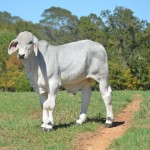
Polled Calves Can Produce a Profit
Dehorning calves can have a tremendous impact on end-product quality and value of feeder/stocker cattle.
It may seem like one of the simpler management processes, but it still gets overlooked. Angus cattle, for instance, are naturally polled—and breeding cattle to Angus bulls is an easy way to remove horns naturally without the stress of using mechanical means.
According to the most recent National Animal Health Monitoring System (NAHMS) report, the percentage of calves marketed with horns, across all states evaluated, had decreased from 8.4% in 1992 to 6.3% in 2007.
The authors speculated that a majority of this decrease was due to the use of polled genetics. However, another import finding was that fewer calves born with horns were dehorned on the operation.
The 2007-08 NAHMS report also evaluated dehorning practices by geographical region.
It found that the South Central region (Texas and Oklahoma) had the highest percentage of calves born in 2007 that had or were expected to have horns (22.8%). The East region (Alabama, Arkansas, Florida, Georgia, Kentucky, Louisiana, Mississippi, Tennessee and Virginia) had only 9.8% calves with horns but only dehorned 39.5% of those calves.
The West and Central regions dehorned a much higher percentage of calves born with horns (70% combined).
The presence of horns has a consistently negative effect on the selling price of feeder calves.
Reports from eastern Oklahoma, evaluating the sale price of more than 9,000 head, have shown that horned steers bring $3.23/cwt less than their polled or dehorned contemporaries.
Reports from the Southeastern states estimate that polled or dehorned calves sell for $1.50 to $2.00/cwt more than horned calves.
Horned feeders sell for less because they require dehorning when they arrive to the feedlot and that negatively impacts their performance and health. If they are not dehorned, they decrease the value of the entire pen they feed with.
The 2005 National Beef Quality Audit reported that 22.3% of the cattle passing through 16 packing plants had horns. This represented a reduction from previous reports dating back to 1991 but still does not meet the industry goal of reducing horns on fed cattle to less than 5%.
One of these previous reports estimated the loss due to horns on fed cattle to be $1.00 for every finished animal marketed. The reduction in value comes from the increased incidence of bruising, especially on high-priced cuts, that has to be trimmed from the carcass.
Dehorning replacement females and bulls is also very important.
Horned cows can cause damage to other cattle during transportation and are often difficult to work in a handling facility. Non-fed market animals (cull cows and bulls) also experience a significant amount of carcass trim from bruising when they are managed or hauled with horned cattle.
Source: Justin Rhinehart, Beef Cattle Specialist; Mississippi State University Extension Service


